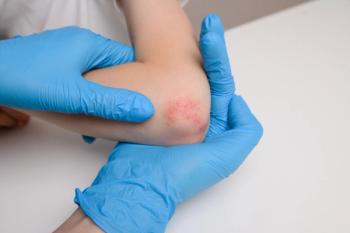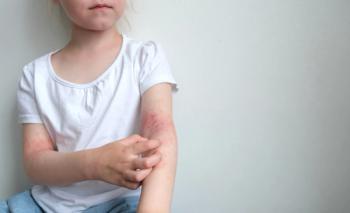
Increase Seen in Eczema, Prevalence Varies by Race and Ethnicity
Previous surveys suggested care disparities. Investigators compared these outcomes because of a lack of research in this space.
Findings from this new cross-sectional study were published online today in
Using data from the US National Health Interview Survey, specifically responses to a question asking about eczema/skin allergy prevalence over the past year, the final analysis included 88,523 children aged 0 to 5 years (33.0%); 67,074 aged 6 to 10 years (27.8%); and 105,291 aged 11 to 17 years (39.2%). Most participants were male patients (51.5%) and of self-reported White race (75.1%). The other races represented were Black (14.9%), multiracial (4.7%), Asian (4.2%), and American Indian or Alaskan Native (1.1%).
“Surveys suggest that disparities in care may exist between sociodemographic subgroups,” the study authors wrote. “We investigated the prevalence of eczema in children in the United States from 1997 to 2018 by sociodemographic subgroup.”
An initial overall prevalence of 7.9% (95% CI, 7.3%-8.5) was seen in the first year of the study, and by the end, this had risen to 12.6%. The average annual percentage change (AAPC) was 2.8% (1.8%-3.8%). However, a joinpoint regression found that overall prevalence only increased between 1997 and 2010, stabilizing thereafter.
When considering the factor of age, the AAPC remained consistent across most categories, ranging from 2.6% (95% CI, 2.0%-3.2%) among children aged 11 to 17 years to 2.9% (95% CI, 1.9%-4.0%) among those aged 6 to 10 years and from 2.7% (95% CI, 1.8%-3.7%) in male patients to 2.8% (95% CI, 2.2%-3.5%) in female patients. In addition, over the course of the study, prevalence in the age groups rose most among children aged 0 to 5 years: from 8.1% (95% CI, 7.2%-9.1%) to 13.7% (95% CI,12.1%-15.5%).
There was also a sharper increase seen among female patients, with their eczema prevalence increasing from 8.1% (95% CI, 7.3%-9.0%) to 12.9% (95% CI, 11.6%-14.3%) compared with 7.7% (95% CI, 7.0%-8.5%) to 12.2% (95% CI, 11.0%-13.6%) in male patients. AAPC, however, was consistent between these groups, at 2.8% (95% CI, 2.2%-3.5%) and 2.7% (95% CI, 1.8%-3.7%), respectively.
When outcomes were evaluated by race, the lowest initial findings were seen among patients of American Indian/Alaskan Native race, at 3.4% (95% CI, 1.3%-8.5%), and this remained the case by the end of the study period, with a prevalence of 6.5% (95% CI, 3.2%-12.8%). Further, patients reporting Asian ethnicity, although starting the study at a higher 11.1% (95% CI, 8.0%-15.3%), saw little change; by 2018, prevalence had only risen to 11.5% (95% CI, 8.8%-14.8%). Greater difference were seen among patients reporting a White ethnicity, whose prevalence rose from 7.3% (95% CI, 6.7%-8.0%) to 11.3% (95% CI, 10.3%-12.4%), and among patients reporting they were multiracial, from 9.7% (95% CI, 7.3%-12.7%) to 16.7% (95% CI, 13.1%-21.0%).
However, patients reporting a Black ethnicity had the sharpest increase in eczema prevalence, with a jump from 10.1% (95% CI, 8.6%-11.8%) to 18.4% (95% CI, 15.4%-21.8%).
For the races reported in the study, the AAPC was highest among multiracial patients (3.9%; 95% CI, 1.8%-6.0%), followed by Black patients (3.5%; 95% CI, 1.8%-5.1%), Asian (2.6%; 95% CI, 1.1%-4.1%) and American Indian/Alaskan Native patients (2.6%; 95% CI, –0.9% to 6.2%), and White patients (2.5%; 95% CI, 1.9%-3.1%).
A final analysis was conducted between patients reporting or not reporting Hispanic ethnicity, considered a sociodemographic subgroup in this analysis. These findings were considered statistically significant, even though “there were 197 and 28 missing values in race and Hispanic ethnicity variables,” the authors wrote. Among these patients, prevalence changes and AAPCs were similar.
The prevalence of eczema rose from 5.6% (95% CI, 4.7%-6.6%) to 10.6% (95% CI, 9.0%-12.4%) among those reporting Hispanic ethnicity and 8.3% (95% CI, 7.7%-9.0%) to 13.2% (95% CI, 12.1% to 14.4%) among those not reporting Hispanic ethnicity. The corresponding AAPCs were 2.5% (95% CI, 1.9%-3.1%) and 2.7% (95% CI, 1.7%-3.8%).
The researchers believe their findings may indicate diagnostic changes among certain racial and ethnic minority groups, and that these changes may have been influenced by social determinants of health, “among noninstitutionalized children in the United States.”
“More research among pediatric racial and ethnic minority populations is warranted,” they concluded.
Reference
1. Choragudi S, Yosipovitch G. Trends in the prevalence of eczema among US children by age, sex, race, and ethnicity from 1997 to 2018. JAMA Dermatol. Published online February 22, 2032. doi:10.1001/jamadermatol.2022.6647
Newsletter
Pharmacy practice is always changing. Stay ahead of the curve with the Drug Topics newsletter and get the latest drug information, industry trends, and patient care tips.




























































































































